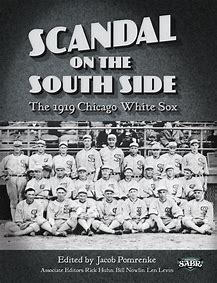The epitome of baseball bad boys are the infamous Chicago Black Sox. Most people know them as a group of eight, as it was in some cases probably guilt by association. There were obviously some good ball players in that group, evidenced by the fact that they made it to the 1919 World Series. It was also a time when baseball wasn’t scrutinized by an acting commissioner, perhaps easier to get away with a crime. It also undoubtedly spurred the need for an overall leader.
The guilty eight were officially banned from baseball in 1921 by Commissioner Kenesaw Landis, probably one of his first acts. As a result, none of them, of course, are in the Hall of Fame, despite their abilities to play the game or the accomplishments that they achieved. The unusual best-of-nine series against the Cincinnati Reds. Redland Field in Cincinnati and Comiskey Park Chicago were the venues involved. Hall of Fame umpire Billy Evans joins Edd Roush of the Reds and Eddie Collins, Red Faber, and Ray Schalk of the Sox in Cooperstown, although Schalk did not play. Dickie Kerr, already mentioned, was the ninth player involved but has been reinstated.
The Sox team was essentially still intact from their 1917 Championship. World War I had taken a toll on the 1918 roster. Shoeless Joe Jackson was the unquestioned star. They were first known as the “Black Sox” because owner, Charles Comiskey, supposedly wouldn’t pay to have their uniforms laundered regularly and they consequently became blacker and blacker, as did their alleged indiscretions. The first signs of trouble were when knuckleballer, Eddie Cicotte, lost his first two starts in the Series. One unsubstantiated story says that he grew bitter towards Comiskey, who denied him five starts toward the end of the season, ending his chances for a 30-win bonus. He went 29-7 on the season. Comiskey claims that he was saving his arm for the Series but may have selfishly saved himself $10,000 in the process, enough to certainly wash the unforms. Cicotte did win game #7, extending the Series.
Chicago’s other ace, Lefty Williams, lost the other three games. It’s a World Series record that will probably never be broken by a starter. He finished the season 23-11 and saved a league-leading 40-games.
Chick Gandil was the mastermind and ringleader of the scandal and admitted his role and implicated others in the scandal via a 1956 Sports Illustrated interview and article. Fred McMullin was just a backup infielder, however, after hearing discussions about the take, he threatened disclosure unless included. The last living member of the scandal, and another ringleader, was shortstop Charles “Swede” Risberg who died in 1975. Centerfielder Happy Felsch hit and fielded poorly throughout the Series.
There are reasons to believe that “Shoeless” Joe Jackson was not involved, but rather in the wrong place at the wrong time. His manager, Buck Weaver, was also controversially banned, having knowledge of the conspiracy but not reporting it. Weaver did successfully sue Charles Comiskey for his 1921 salary. Once again, Comiskey was trying to save a buck, in this case from the real Buck.
Next, we’ll cover the other Commissioners and their impact on keeping the game clean and respectable.

Leave a Reply